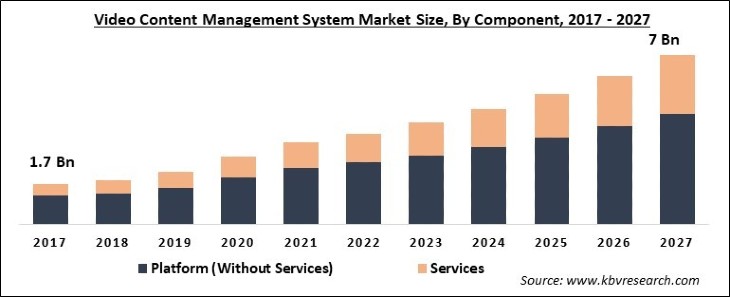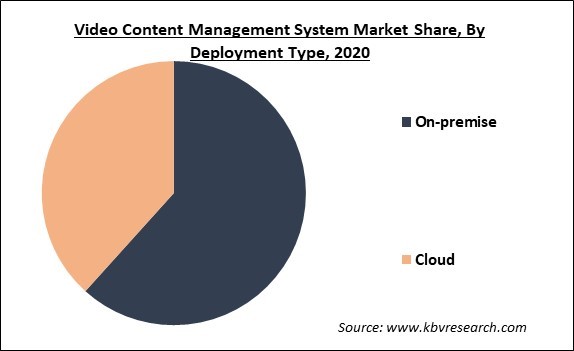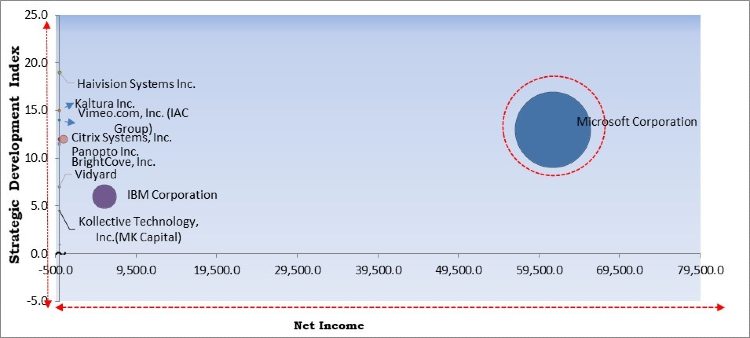The Global Video Content Management System Market size is expected to reach $7 billion by 2027, rising at a market growth of 12.8% CAGR during the forecast period. Video content management refers to the system that can organize and manage media content such as text, videos, and graphic imagery in an extremely effective manner. A video content management system has the features that enable an enterprise to search and sort by different keywords and data points to make findings.
With the help of a video content management system, companies can better store, manage, organize, and post online video content. A video CMS enables users to create a complex, scalable video solution without the need for any programming knowledge. Video content management systems are utilized for public-facing videos such as ads and tutorials, and private videos such as training & internal messaging. Companies that are highly dependent on video for external as well as internal communications should implement a video CMS for their benefits in comparison to a non-specialized system.
Due to the existence of many key players, the video content management system market is likely to witness bright prospects over the forthcoming years. A major catalyst for the growth of the global video content management market is the increase in the number of companies and SMEs across different industries such as BFSI, healthcare and Lifesciences, education, IT and telecom, media and entertainment, retail, and eCommerce and their huge adoption of cloud services and internet penetration. Moreover, the growth of the market is also driven by emerging nations across the globe.

The outbreak of the COVID-19 pandemic has increased the demand for the video content management system market. The companies faced unparalleled and complicated obstacles due to the global pandemic and the adoption of the work-from-home model. The need for alternate business models has been emerged due to the economic slowdown because of the contagious and fatal nature of coronavirus.
This could impact the behavior of customers because they can become habitual of online shopping, hence making it a new normal, and it becomes difficult to come out of this habit easily. As a result, companies have been forced to increase their online presence. Companies across various industrial verticals are harnessing the potential of video content management systems because of the flexibility of managing big video files, improves corporate communication, and provides possibilities for marketing, promotion, and address live audiences.
According to the industry experts, the viewers for video content grew by 250% and live stream events by 300%. The stringent lockdown restrictions have compelled many companies to deploy the work-from-home policy, thereby allowing people to work remotely. Companies are adopting video-based communication solutions like web-based communication through video calling and video conferencing in order to improve collaboration and communication between employees.
There is an increasing demand for well-developed and high-quality video service among the customers and companies as advanced video equipment is becoming more affordable. In addition, the high demand for real-time video service for incident management would further enable authorities to better respond to disastrous and emergency situations like thefts, fire incidents, security breaches, natural calamities, road accidents, and among others.
Companies face major concerns due to the security and privacy of the video content shared across several platforms. In addition, companies are apprehensive about Digital Rights Management (DRM) and copyright because of the chances of information leakages, misuse, and data breaches. In 2019, the cases of data breach were biggest in healthcare, manufacturing, finance, information, and public sectors. Companies must redefine their strategies in deploying video conferencing capabilities before installing these solutions in order to address these challenges.

Based on Component, the market is segmented into Platform (Without Services) and Services. The services segment would showcase the prominent growth rate during the forecast period. Factor such as the increase in the amount of video content consumption and cloud-based video services is responsible for the growth of the segment. Services are extremely required for simple installation, integration, and appropriate functioning of the video content management system.
Based on Application, the market is segmented into Enterprise Communication, Virtual Events, Education & Learning, Marketing & Client Engagement, Recruitment & Training and Others. The Enterprise Communication market dominated the Global Video Content Management System Market by Application 2020. The Virtual Events market is expected to witness a CAGR of 12% during (2021 - 2027).
Based on Deployment Type, the market is segmented into On-premise and Cloud. The on-premises segment obtained the maximum revenue share of the video content management market in 2020. Moreover, the segment is likely to acquire a prominent revenue share during the forecasting period. This is because large enterprises majorly deploy on-premises video content management services in order to gain complete control over their infrastructure and data, maintaining the strong security of data regarding the integration with internal company systems like customer relationship management, sales management system, and employee management system.
Based on End User, the market is segmented into BFSI, Retail & eCommerce, Media & Entertainment, Healthcare, Education, Telecom & IT, and Others. The education segment is currently witnessing the massive deployment of video content management solutions, thus offering lucrative growth opportunities for the vendors of solutions. The higher education category and K-12 fall under the education segment. The video content has been created at a wide scale due to the transition of education to online mode due to the closure of schools, colleges, and other kinds of educational institutes. Moreover, the market players are likely to witness new growth avenues due to the massive surge in the adoption rate of digital platforms by educational institutes.
| Report Attribute | Details |
|---|---|
| Market size value in 2020 | USD 2.8 Billion |
| Market size forecast in 2027 | USD 7 Billion |
| Base Year | 2020 |
| Historical Period | 2017 to 2019 |
| Forecast Period | 2021 to 2027 |
| Revenue Growth Rate | CAGR of 12.8% from 2021 to 2027 |
| Number of Pages | 317 |
| Number of Tables | 494 |
| Report coverage | Market Trends, Revenue Estimation and Forecast, Segmentation Analysis, Regional and Country Breakdown, Competitive Landscape, Companies Strategic Developments, Company Profiling |
| Segments covered | Component, Application, Deployment Type, End User, Region |
| Country scope | US, Canada, Mexico, Germany, UK, France, Russia, Spain, Italy, China, Japan, India, South Korea, Singapore, Malaysia, Brazil, Argentina, UAE, Saudi Arabia, South Africa, Nigeria |
| Growth Drivers |
|
| Restraints |
|
Based on Regions, the market is segmented into North America, Europe, Asia Pacific, and Latin America, Middle East & Africa. APAC is likely to exhibit the highest growth rate over the forecast years. Factors such as massive penetration of smart devices, rapid rate of digitalization of enterprises, high economic development, high-speed internet connectivity, and increase in the foreign investments in countries like India, Malaysia, Indonesia, and the existence of established countries like China, Japan, Australia, and South Korea are responsible for the growth & demand for these solutions in the region.
Free Valuable Insights: Global Video Content Management System Market size to reach USD 7 Billion by 2027

The major strategies followed by the market participants are Product Launches. Based on the Analysis presented in the Cardinal matrix; Microsoft Corporation are the forerunners in the Video Content Management System Market. Companies such as IBM Corporation and Citrix System, Inc. are some of the key innovators in the market.
The market research report covers the analysis of key stake holders of the market. Key companies profiled in the report include IBM Corporation, Vimeo.com, Inc. (IAC Group), Microsoft Corporation, BrightCove, Inc., Panopto Inc., Kaltura Inc., Buildscale, Inc. (Vidyard), Citrix Systems, Inc., Haivision Systems Inc., and Kollective Technology, Inc. (MK Capital).
By Component
By Application
By Deployment Type
By End User
By Geography
The video content management system market size is projected to reach USD 7 billion by 2027.
Online video content is witnessing high demand in the market are driving the market in coming years, however, concerns regarding privacy and data security limited the growth of the market.
Google, Inc., Amazon.com, Inc., Microsoft Corporation, Adobe, Inc., Cisco Systems, Inc., Zoom Video Communications, Inc., Avaya Holdings Corporation, Plantronics, Inc. (Polycom, Inc.), RingCentral, Inc., and Zoho Corporation Pvt. Ltd.
The expected CAGR of the video content management system market is 12.8% from 2021 to 2027.
The On-premise market dominated the Global Video Content Management System Market by Deployment Type 2020, thereby, achieving a market value of $4,108.2 million by 2027.
North America would procure the maximum revenue share of the video content management market during the forecasting period.
Our team of dedicated experts can provide you with attractive expansion opportunities for your business.

